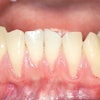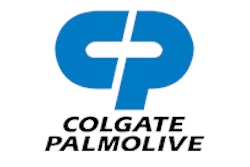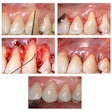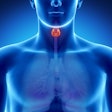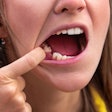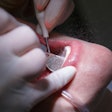
Some surprising results from a study designed to find ways to streamline new product development at Colgate-Palmolive could pave the way for the development of a chairside periodontal health assessment tool (Journal of Dental Research, September 2009, Vol. 88:9, pp. 851-855).
Using a molecular analysis technique called metabolomics, researchers from Colgate-Palmolive Technology Center, the Forsyth Institute, and Metabolon set out to test whether the cellular metabolism of diseased periodontal tissue is altered as a result of the host-bacteria interaction. They also wanted to identify biomarkers associated with periodontal disease that could help streamline the clinical trials Colgate goes through each time it develops a new product and make their research more predictable, said Lining Guo, study co-author and senior director of commercial operations for Metabolon.
“Our outcomes were much better than we anticipated.”
— Lining Guo, Metabolon
"The initial intent was to discover biomarkers associated with periodontal disease," he said. "Then Colgate can evaluate how their products compare to the biomarkers."
Twenty-two people (ages 33-67) with chronic periodontitis were selected from volunteers at the Forsyth Institute Dental Clinic. Each participant had at least 20 natural uncrowned teeth, at least eight sites with pocket depth of 5 mm or more, and clinical attachment level of 3 mm or more.
During their first visit to the clinic, each participant was given a tube of Colgate Regular and a toothbrush and instructed to use the product at least one week. Samples of gingival crevicular fluid (GCF) were then collected from each participant using periopaper strips. For each patient, six healthy, six gingivitis, and three periodontitis sites were sampled. A total of 330 GCF samples were collected.
The samples were then analyzed using Metabolon's proprietary metabolic profiling process, which identifies biomarkers that are useful in the development of diagnostic products and provides insight into complex biochemical processes by producing an instantaneous "snapshot" of a cell's physiology. This is the first time Metabolon's platform has been used in a dental application, according to Guo.
After being extracted from the GCF collection strips, the metabolites were analyzed using chromatographic separation followed by full-scan mass spectroscopy to identify all detectable ions. Using this method, Guo and his colleagues were able to detect 228 metabolites, of which 103 matched known chemical structures in their chemical reference library.
Unexpected results
This is where things got interesting, Guo said.
"Our outcomes were much better than we anticipated," he said. "We discovered a panel of very comprehensive biomarkers. And we not only found the biomarkers that Colgate needs, we also discovered some significant disease mechanisms."
One of the most exciting findings, he said, was that the purine degradation pathway -- a major biochemical source for reactive oxygen species production -- was significantly accelerated at the disease sites.
"This suggests that periodontal-disease-induced oxidative stress and inflammation are mediated through this pathway," the researchers wrote. Among other things, this pathway is responsible for the generation of hydrogen peroxide. By using metabolic profiling, Guo and his colleagues discovered that when disease is present in the host tissue, the generation of hydrogen peroxide accelerates, causing tissue destruction.
"There has been a lot of research in the last few years that concluded that when bacteria colonize the host site (periodontal tissue), this is what causes tissue destruction," he said. "But in a lot of cases, the tissue destruction is due to the host tissue trying to defend itself against the bacteria. It will induce defensive pathways to try and kill the bacteria, and when those pathways go into overdrive, it actually hurts the tissue."
The study findings provide evidence for the first time that the progression of periodontal diseases can be attributed, at least in part, to the purine degradation pathway and xanthine oxidase, the researchers wrote. "While it is plausible that the increased purine degradation could result from the breakdown of DNA molecules related to tissue damage, the mostly likely cause is that host tissues up-regulate this pathway as a defense mechanism against bacterial pathogens."
In another unexpected finding, they also discovered the biochemical origins of anti-oxidant depletion and its role in periodontal disease and tissue destruction. The level of uric acid -- the end-product of the purine degradation pathway and a known cellular anti-oxidant -- was decreased at the disease sites, as was the level of ascorbic acid, another cellular anti-oxidant, and glutathione, which plays a central role in cellular defense against free radicals and xenobiotics, according to the researchers.
"We have identified metabolic changes associated with periodontal disease progression that were previously unknown or unclear," they wrote. "Many potential biomarkers have been proposed as diagnostic candidates for periodontal diseases, especially enzymes of host or bacterial origin. However, because of concerns with specificity and sensitivity, the utility of these markers is uncertain. In this study, the simultaneous measurement of approximately 200 metabolites in GCF provided a more comprehensive picture of the complex host-bacteria interaction than previous targeted analyses."
Guo said Metabolon's long-term vision is to develop a rapid periodontal health assessment tool for use in the dental office or even at home.
"When people go to the dentist, they are sometimes hesitant to get certain treatments done," he said. "We believe we could actually use this test to assess the periodontal health of each possible site in the mouth and then show the patient right then what could happen if they don't treat it. We could possibly even turn it into a consumer product, a strip test, for home-based testing of periodontal health."
All of this is, he admits, a few years down the road. "The technologies are fairly complex, but we see this as a discovery platform."
Copyright © 2009 DrBicuspid.com
